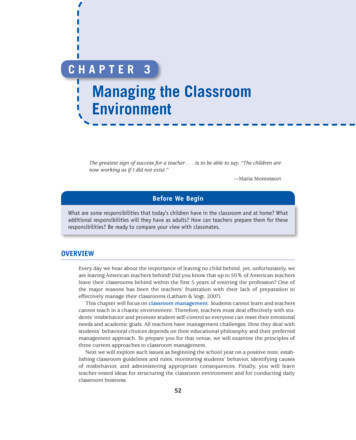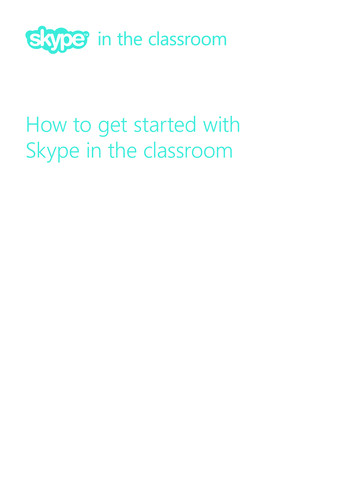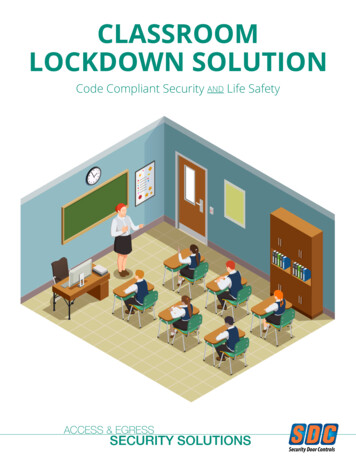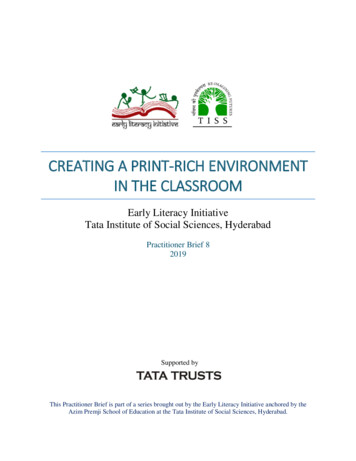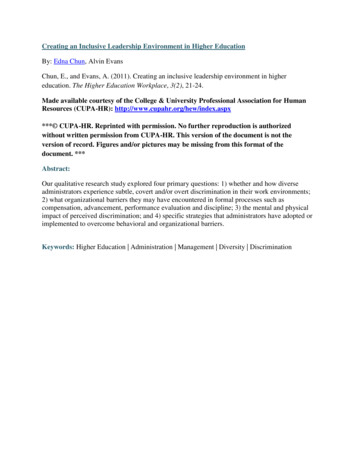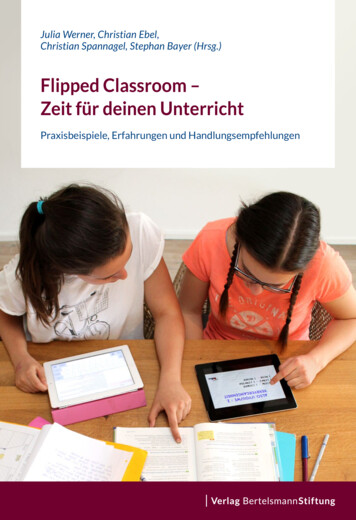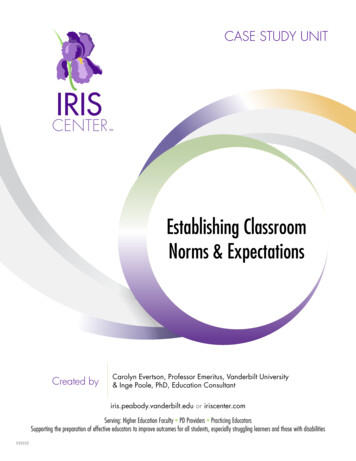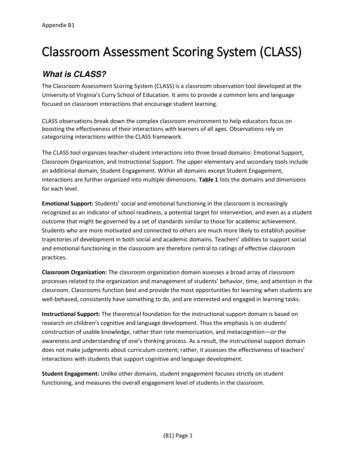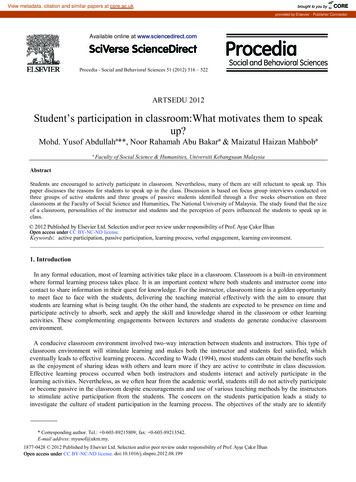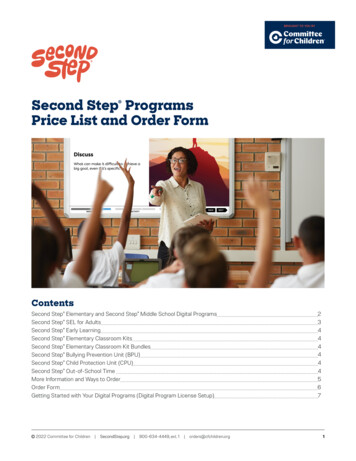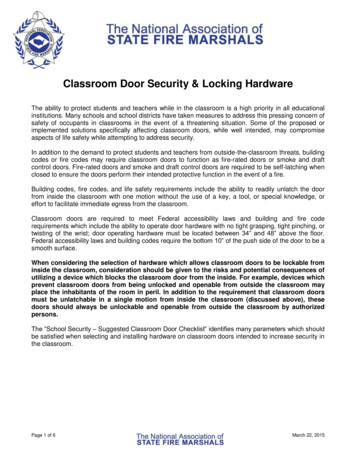
Transcription
Creating aClassroomEnvironmentThat PromotesPositive Behavior
MATTHEWJust as Ms. McLeod is beginning a lesson, Matthew approaches her with a question.Ms. McLeod tells Matthew that she cannot answer it now and asks him to return tohis seat. On the way to his seat, Matthew stops to joke around with his classmates,and Ms. McLeod again asks him to sit in his seat. Matthew walks halfway to hisdesk and then turns to ask one of his classmates if he can borrow a piece of paper.Again, Ms. McLeod asks him to find his seat, and he finally complies.The class begins the lesson, with Ms. McLeod asking the students variousquestions. Matthew calls out the answers to several questions, and Ms. McLeodreminds him to raise his hand. As the lesson continues, Matthew touches anotherstudent, and the student swats Matthew’s hand away. He then makes faces atMaria, who is sitting next to him. Maria laughs and starts sticking her tongue outat Matthew. Matthew raises his hand to respond to a question but cannotremember what he wants to say when Ms. McLeod calls on him, and startsmaking up a story and telling jokes. The class laughs, and Ms. McLeod tellsMatthew to pay attention.As Ms. McLeod begins to give directions for independent work, Matthew staresout the window. Ms. McLeod asks him to stop and get to work. He works on theassignment for 2 minutes and then “trips” on his way to the wastepaper basket.The class laughs, and Ms. McLeod tells Matthew to return to his seat and get towork. When he reaches his desk, he begins to search for a book, and makes a jokeabout himself. His classmates laugh, and Ms. McLeod reminds Matthew to workon the assignment. At the end of the period, Ms. McLeod collects the students’work, and notes that Matthew and many of his classmates have only completed asmall part of the assignment.What strategies could Ms. McLeod use to help Matthew improve his learning andbehavior? After reading this chapter, you should have the knowledge, skills, and dispositions to answer that as well as the following questions: How can I collaborate with others to conduct a functional behavioralassessment? How can I promote positive classroom behavior in students? How can I prevent students from harming others? How can I adapt the classroom design to accommodate students’ learning, socialand physical needs?or students to be successful in inclusive settings, their classroom behaviormust be consistent with teachers’ demands and academic expectations andmust promote their learning and socialization with peers. Appropriate academic, social, and behavioral skills allow students to become part of the class, theschool, and the community. Unfortunately, for reasons both inside and outside theclassroom, the behavior of some students like Matthew may interfere with theirlearning and socialization as well as that of their classmates. Therefore, you mayneed to have a comprehensive and balanced classroom management plan. This involves using many of the different strategies and physical design changes discussedin this chapter to help your students engage in behaviors that support their learning and socializing with others. A good classroom management system recognizesthe close relationship between positive behavior and effective instruction. Therefore, an integral part of a classroom management system includes your use of suchF
278Set Your SitesTo link to websites that supportand extend the content of thischapter, go to the Set Your Sitesmodule in Chapter 7 of theCompanion Website.ResourceFor a listing of helpful resourcearticles and books that extend thecontent and discussions presentedin this chapter, go to theResource module in Chapter 7 onthe Companion Website.Chapter 7: Creating a Classroom Environment That Promotes Positive Behavioreffective instructional practices as understanding students’ learning and socialneeds; providing students with access to an engaging and appropriate curriculum;and using innovative, motivating, differentiated teaching practices and instructionalaccommodations, which are discussed in greater detail in other chapters. As welearned in Chapters 4 and 5, it is also important to foster communication and collaboration with other professionals and families and to create a welcoming andcomfortable learning environment, as well as to communicate with students, respect them, care for them, and build relationships with them. If students are classified as having a disability, your schoolwide and classroom policies and practicesneed to be consistent with certain rules and guidelines for disciplining them (Smith& Katsiyannis, 2004).SCHOOLWIDE POSITIVE BEHAVIORALSUPPORT SYSTEMYour classroom management plan should be consistent with and include theservices available in your school’s positive behavioral support system (Leedy, Bates,& Safran, 2004; Stormont, Lewis, & Beckner, 2005; Strout, 2005). A schoolwide approach to supporting the learning and positive behavior of all students involvesthe collaboration and commitment of educators, students, and family and community members to agree on unified expectations, rules, and procedures; use wrap-around school- and community-based services and interventions; create a caring, warm, and safe learning environment and community ofsupport; understand and address student diversity; offer a meaningful and interactive curriculum and a range of individualizedinstructional strategies; teach social skills and self-control; and evaluate the impact of the system on students, educators, families, and thecommunity and revise it based on these data (Epstein et al., 2005; Kern & Manz,2004; Leedy et al., 2004; Sobel, Taylor, & Worthman, 2006; Stormont et al., 2005;Sugai & Horner, 2001; Walker & Schutte, 2004).ReflectiveWhat social and behavioral skillsare important for success in yourclassroom?Positive behavioral interventions and supports are proactive and culturally sensitive in nature and seek to prevent students from engaging in problem behaviors bychanging the environment in which the behaviors occur and teaching prosocial behaviors (Duda & Utley, 2005). Positive behavioral interventions and supports also areemployed to help students acquire the behavioral and social skills that they will needto succeed in inclusive classrooms (Choutka,Doloughty,& Zirkel,2004;Lane,Pierson,&Givner, 2004; Lane et al., 2006). Sobel et al. (2006) present schoolwide and classroombased positive behavioral strategies and supports for use with a wide range of students. This also may include a functional behavioral assessment and a behavioralintervention plan. In the following sections, you will learn how to collaborate withothers to conduct a functional behavioral assessment and how to implement specificpositive behavioral interventions.
www.prenhall.com/salendHOW CAN I COLLABORATE WITH OTHERS TOCONDUCT A FUNCTIONAL BEHAVIORALASSESSMENT?A functional behavioral assessment (FBA) is a person-centered, multimethod,problem-solving process that involves gathering information to measure student behaviors; determine why, where, and when a student uses these behaviors; identify the instructional, social, affective, cultural, environmental, andcontextual variables that appear to lead to and maintain the behaviors; and plan appropriate interventions that address the purposes the behaviors serve forstudents (Chandler & Dahlquist, 2006; Pindprolu, Lignugaris/Kraft, Rule,Peterson, & Slocum, 2005).Although an FBA is only one aspect of a comprehensive behavior support planningprocess (e.g., medical, and vocational factors and systems of care and wrap-aroundprocesses should also be identified and considered), it helps educators and familymembers develop a plan to change student behavior by (a) examining the causes andfunctions of the student’s behavior and (b) identifying strategies that address the conditions in which the behavior is most likely and least likely to occur (Umbreit, Ferro,Liaupsin,& Lane,2007).Guidelines for conducting an FBA and examples relating to thechapter-opening vignette of Matthew and Ms. McLeod are presented here.CREATE A DIVERSE MULTIDISCIPLINARY TEAMIn conducting an FBA, you will collaborate with a diverse team that includes educators,and family and community members (Barnhill, 2005; Gable et al., 2003; Scott, Liaupsin,Nelson, & Jolivette, 2003). The team typically includes the student’s teacher(s), professionals who have expertise in the FBA process, and administrators who can ensure thatthe recommendations outlined in the behavioral intervention plan are implemented.The inclusion of family members also can provide the team with important informationabout the student’s history and home-based events that may affect the student and thefamily (Fox & Dunlap, 2002). Expanding the team to include community members aswell as professionals who will be culturally sensitive to the student’s background allowsthe team to learn about the student’s cultural perspective and experiential and linguistic background,and to determine whether the student’s behavior has a sociocultural explanation. In the case of Matthew, the team was composed of two of his teachers, hismother and brother, a school psychologist who had experience with the FBA process,the principal at his school, and a representative from a community group.IDENTIFY THE PROBLEMATIC BEHAVIORSFirst, the team identifies the behavior that will be examined by the FBA by consideringthe following questions:(a) What does the student do or fail to do that causes a problem?(b) How do the student’s cognitive, language, physical, and sensory abilities affect thebehavior? (c) How does the behavior affect the student’s learning, socialization, and selfconcept, as well as classmates and adults? For example, in the chapter-opening vignette,Matthew’s poor on-task behavior seems to be undermining both his learning and theclassroom environment. When several behaviors are identified as problematic, it is recommended that they be prioritized based on their level of interference (Murdick, Gartin,& Stockall, 2003).279
280Chapter 7: Creating a Classroom Environment That Promotes Positive BehaviorThe team also needs to examine the relationship,if any,between the behavior andthe student’s cultural and language background (Salend & Garrick Duhaney, 2005;Voltz et al.,2005).Some students from diverse backgrounds may have different culturalperspectives than their teachers,and communication problems between students andteachers often are interpreted by teachers as behavioral problems. For example, a student may appear passive in class, which may be interpreted as evidence of immaturityand lack of interest. However, in the student’s culture, the behavior may be considereda mark of respect for the teacher as an authority figure.DEFINE THE BEHAVIORReflectiveHow would you define, inobservable and measurableterms, and what recordingstrategies would you use to assessout-of-seat, inattentive,aggressive, tardy, noisy, anddisruptive behavior?Next, the behavior is defined in observable and measurable terms by listing its characteristics (Barnhill, 2005). For example, Matthew’s off-task behavior can be definedin terms of his calling out and extraneous comments, his extensive comments relatedto teacher questions, his ability to remain in his work area, his interactions with classmates, and the amount of work he completed.OBSERVE AND RECORD THE BEHAVIORAfter the behavior has been defined, the team selects an appropriate observationalrecording method and uses it during times that are representative of typical classroomactivities (Alberto & Troutman, 2006). Examples of different observational recordingsystems are presented in Figure 7.1.FIGURE 7.1 Example of observational recording strategiesDateLength ofSessions9/1130 minutes9/1530 minutes9/2030 minutesNumberof Events(a) Event Recording of ) Duration Recording of Out-of-seat Behavior15 Sec15 Sec15 Sec15 Sec (c) Interval Recording of On-task BehaviorTotalDuration5 minutes3 minutes2 minutes1 minute4 minutes
www.prenhall.com/salend281Event RecordingIf the behavior to be observed has a definite beginning and end and occurs for brieftime periods, event recording is a good choice. In event recording, the observercounts the number of behaviors that occur during the observation period, as shownin Figure 7.1a.For example,event recording can be used to count the number of timesMatthew was on task during a typical 30-minute teacher-directed activity. Data collected using event recording are displayed as either a frequency (number of times thebehavior occurred) or a rate (number of times it occurred per length of observation).You can use an inexpensive grocery, stitch, or golf counter for event recording. Ifa mechanical counter is not available, marks can be made on a pad, an index card, achalkboard, or a piece of paper taped to the wrist. You also can use a transfer systemin which you place small objects (e.g., poker chips, paper clips) in one pocket andtransfer an object to another pocket each time the behavior occurs. The number ofobjects transferred to the second pocket gives an accurate measure of the behavior.Duration and Latency RecordingIf time is an important factor in the observed behavior,a good recording strategy wouldbe either duration or latency recording.In duration recording, shown in Figure 7.1b,the observer records how long a behavior lasts. Latency recording, on the otherhand, is used to determine the delay between receiving instructions and beginning atask. For example, duration recording can be used to find out how much time Matthewspends on task. Latency recording would be used to assess how long it took Matthewto begin an assignment after the directions were given. The findings of both recordingsystems can be presented as the total length of time or as an average. Duration recording data also can be summarized as the percentage of time the student engaged in thebehavior by dividing the amount of time the behavior lasts by the length of the observation period and multiplying by 100.Interval Recording or Time SamplingWith interval recording or time sampling, theobservation period is divided into equal intervals, and the observer notes whether the behavior occurred during each interval; a plus ( )indicates occurrence and a minus ( ) indicatesnonoccurrence. A does not indicate howmany times the behavior occurred in that interval, only that it did occur. Therefore, this systemshows the percentage of intervals in which thebehavior occurred rather than how often it occurred.The interval percentage is calculated by dividing the number of intervals in which the behavior occurred by the total number of intervalsin the observation period and then multiplyingby 100. For example, you might use intervalrecording to record Matthew’s on-task behavior.After defining the behavior, you would dividethe observation period into intervals and construct a corresponding interval score sheet, as shown in Figure 7.1c. You would thenrecord whether Matthew was on task during each interval. The number of intervals inwhich the behavior occurred would be divided by the total number of intervals to determine the percentage of intervals in which he was on task.Observing students and recordingtheir behavior can provide valuableinformation. What types ofinformation can observations giveyou about your students?
282Chapter 7: Creating a Classroom Environment That Promotes Positive BehaviorAnecdotal RecordsAn anecdotal record, also known as a narrative log or continuous recording, is oftenuseful in reporting the results of the observation (Rao, Hoyer, Meehan, Young, &Guerrera, 2003; Zuna & McDougall, 2004). An anecdotal record is a narrative of theevents that took place during the observation; it helps you understand the academiccontext in which student behavior occurs, and the environmental factors that influence student behavior. Use the following suggestions to write narrative anecdotalreports: Give the date, time and length of the observation. Describe the activities, design, individuals, and their relationships to the settingin which the observation occurred. Report in observable terms all of the student’s verbal and nonverbal behaviors,as well as the responses of others to these behaviors. Avoid interpretations. Indicate the sequence and duration of events.The chapter-opening vignette contains a sample anecdotal record relating to an observation of Matthew.OBTAIN ADDITIONAL INFORMATION ABOUTTHE STUDENT AND THE BEHAVIORAn important part of an FBA is obtaining information regarding the student and thebehavior (Lo & Cartledge, 2006). Using multiple sources and methods, the team gathers information to determine the student’s skills, strengths, challenges, interests, hobbies, preferences, self-concept, attitudes, health, culture, language, and experiences.Data regarding successful and ineffective interventions used in the past with the student also can be collected. Often this information is obtained by reviewing studentrecords and by interviewing the student, teachers, family members, ancillary supportpersonnel, and peers or having these individuals complete a checklist or rating scaleconcerning the behavior (Kamps, Wendland, & Culpepper, 2006; Newcomer & Lewis,2004). Achenbach and Rescorla (2001); Kern, Dunlap, Clarke, and Childs (1994);Lawry, Storey, and Danko (1993); Lewis, Scott, and Sugai (1994); O’Neill et al. (1997);and Reid & Maag (1998) offer interviews and survey questions to identify the perspectives of teachers,students,and family members on student behavior.For example,Ms. McLeod asked Matthew to respond to the following questions: (a) What do I expect you to do during class time? (b) How did the activities and assignments make youfeel? (c) Can you tell me why you didn’t complete your work? (d) What usually happens when you disturb other students? Additional information about Matthew and thedata collection strategies used by the team as part of the functional behavioral assessment process are summarized in Table 7.1.PERFORM AN ANTECEDENTS-BEHAVIOR-CONSEQUENCES(A-B-C) ANALYSISWhile recording behavior, you may use an A-B-C analysis to collect data to identify thepossible antecedents and consequences associated with the student’s behavior(Babkie, 2006; Barnhill, 2005; Knoster, 2000; Mueller, Jenson, Reavis, & Andrews, 2002.Antecedents and consequences are the events, stimuli, objects, actions, and activities that precede and trigger the behavior, and follow and maintain the behavior, respectively. A sample functional behavioral assessment for Matthew that contains anA-B-C analysis of his off-task behavior is presented in Table 7.1.
www.prenhall.com/salendTABLE 7.1283Sample functional behavioral assessment for MatthewBehavior:Off-taskWhat Are the Antecedentsof the Behavior? Teacher-directed activity Content of the activity Individualized nature of theactivity Duration of the activity Location of Matthew’swork area Placement of peers’ workareas Proximity of the teacher Teacher comment or question Availability of otheractivitiesWhat Is the Behavior?Matthew calls out, makesextraneous comments inresponse to teacher questionsor comments, distracts others,leaves his work area, andcompletes a limited amount ofwork.What Are theConsequencesof the Behavior?What Are the Functionsof the Behavior? Receives teacher attention To avoid or express hisdisappointment with the Receives peer attentioninstructional activity Avoids unmotivating To receive attentionactivityfrom adults and peers Performs a pleasant activity(e.g., interacting withpeers) Receives reprimand Leaves seatDATA COLLECTION STRATEGIES: Observations, student, family and teacher interviews, behavior checklists, andstandardized testing.ADDITIONAL INFORMATIONACADEMIC: Mathew has scored significantly above grade level on standardized tests in readingand mathematics.SOCIAL/PEER: Matthew spends time alone after school because there are few activities availablefor him. Matthew’s peers describe him as the class clown. Matthew likes to talk with and work with others.FAMILY: Mathew likes to interact with others in social situations and community events. Matthew does his homework while interacting with others.ANALYZE THE DATAThe A-B-C data are then analyzed and summarized to identify when, where, withwhom, and under what conditions the behavior is most likely and least likely to occur(see Figure 7.2 for questions that can guide you in analyzing the behavior’s antecedents and consequences) (Kamps et al.,2006). The A-B-C analysis data are also analyzed to try to determine why the student uses the behavior, also referred to as theperceived function of the behavior. Functions of the behavior often are related tothe following categories: (a) receiving attention from peers or adults, (b) gaining access to a desired object or activity, (c) avoiding an undesired activity, and (d) addressing sensory and basic needs (Barnhill, 2005; Frey & Wilhite, 2005). The team canattempt to identify the perceived function of the behavior by considering the following questions:1. What does the student appear to be communicating via the behavior?2. How does the behavior benefit the student (e.g., getting attention or help fromothers; avoiding a difficult or unappealing activity; gaining access to a desiredactivity or peers; receiving increased status and self-concept, affiliation withothers, sense of power and control, sensory stimulation or feedback,satisfaction)?
284Chapter 7: Creating a Classroom Environment That Promotes Positive BehaviorFIGURE 7.2 A-B-C analysis questionsIn analyzing the antecedents of student behavior, consider if the behavior is related to the following: Physiological factors such as medications, allergies, hunger/thirst, odors, temperature levels, or lightingHome factors or the student’s cultural perspectiveStudent’s learning, motivation, communication, and physical abilitiesThe physical design of the classroom, such as the seating arrangement, the student’s proximityto the teacher and peers, classroom areas, transitions, scheduling changes, noise levels, size ofthe classroom, and auditory and visual stimuliThe behavior of peers and/or adultsCertain days, the time of day, the length of the activity, the activities or events preceding orfollowing the behavior or events outside the classroomThe way the material is presented or the way the student respondsThe curriculum and the teaching activities, such as certain content areas and instructionalactivities, or the task’s directions, difficulty and staff supportGroup size and/or composition or the presence and behavior of peers and adultsIn analylyzing the consequences of student behavior, consider the following: What are the behaviors and reactions of specific peers and/or adults?What is the effect of the behavior on the classroom atmosphere?How does the behavior affect progress on the activity or the assigned task?How does the behavior relate to and affect the student’s cultural perspective?What encourages or discourages the behavior?3. What setting events contribute to the problem behavior (e.g., the student beingtired, hungry, ill, or on medication; the occurrence of social conflicts, schedulechanges, or academic difficulties; the staffing patterns and interactions)?4. How does the behavior relate to the student’s culture, experiential and languagebackground, and sensory and basic needs?Possible antecedents for Matthew’s behavior include the content, type, duration,and level of difficulty of the instructional activity, the extent to which the activity allows him to work with others, and the location of the teacher. Possible consequencesfor Matthew’s behavior may include teacher and peer attention, and avoiding an unmotivating task.DEVELOP HYPOTHESIS STATEMENTSNext, the prior information collected and the A-B-C analysis data are used to developspecific and global statements,also referred to as summary statements, concerning thestudent and the behavior hypotheses about the student and the behavior,which are verified (Frey & Wilhite, 2005; Newcomer & Lewis, 2004). Specific hypotheses addressthe reasons why the behavior occurs and the conditions related to the behavior including the possible antecedents and consequences.For example,a specific hypothesisrelated to Matthew’s behavior would be that when Matthew is given a teacher-directedor independent academic activity, he will use many off-task behaviors to gain attentionfrom peers and the teacher. Global hypotheses address how factors in the student’slife in school, at home, and in the community impact on the behavior. In the case ofMatthew, a possible global hypothesis can address the possibility that his seeking attention is related to his limited opportunities to interact with peers after school. After hypothesis statements are developed,direct observation is used to validate their accuracy.CONSIDER SOCIOCULTURAL FACTORSWhen analyzing the A-B-C information to determine hypotheses,the team should consider the impact of cultural perspectives and language background on the student’sbehavior and communication (Duda & Utley, 2005; Voltz et al., 2005). Behavioral
www.prenhall.com/salend285differences in students related to their learning histories and behaviors, family’s cultural perspectives, preference for working on several tasks at once, listening and responding styles, peer interaction patterns, responses to authority, verbal and nonverbalcommunication,turn-taking sequences,physical space,eye contact,and student–teacherinteractions can be attributed to their cultural backgrounds (Cartledge et al., 2000;Jensen, 2004; Townsend, 2000).To do this, behavior and communication must be examined in a social/culturalcontext (Duda & Utley, 2005). For example, four cultural factors that may affect students’ behavior in school are outlined here: time, movement, respect for elders, and individual versus group performance. However, although this framework for comparingstudents may be useful in understanding certain cognitive, movement, and interactionstyles and associated behaviors, you should be careful in generalizing a specific behavior to any cultural group. Thus, rather than considering these behaviors as characteristic of the group as a whole, you should view them as attitudes or behaviors thatan individual may consider in learning and interacting with others.TimeDifferent cultural groups have different concepts of time. The Euro-American cultureviews timeliness as essential and as a key characteristic in judging competence.Studentsare expected to be on time and to complete assignments on time. Other cultures mayalso view time as important, but as secondary to relationships and performance (Cloud& Landurand, n.d.). For some students, helping a friend with a problem may be considered more important than completing an assignment by the deadline. Students whohave different concepts of time may also have difficulties on timed tests or assignments.MovementDifferent cultural groups also have different movement styles, which can affect howothers perceive them and interpret their behaviors (Neal, McCray, Webb-Johnson, &Bridgest, 2003). Different movement styles can affect the ways students walk, talk, andlearn. For example, some students may prefer to get ready to perform an activity bymoving around to organize themselves. Other students may need periodic movementbreaks to support their learning.Respect for EldersCultures, and therefore individuals, have different ways to show respect for elders andauthority figures such as teachers (Chamberlain, 2005). In many cultures, teachers andother school personnel are viewed as prestigious and valued individuals who are worthy of respect. Respect may be demonstrated in many different ways, such as not making eye contact with adults, not speaking to adults unless spoken to first, not askingquestions, and using formal titles. Mainstream culture in the United States does not always show respect for elders and teachers in these ways. Therefore, the behaviorsmentioned may be interpreted as communication or behavior problems rather than ascultural marks of respect.Individual versus Group PerformanceThe Euro-U.S. culture is founded on such notions as rugged individualism. By contrast,many other cultures view group cooperation as more important (Chamberlain, 2005).For students from these cultures,responsibility to society is seen as an essential aspectof competence, and their classroom performance is shaped by their commitment tothe group and the community rather than to individual success. As a result, for someAfrican American, Native American, and Latino/a students who are brought up to believe in a group solidarity orientation, their behavior may be designed to avoid beingviewed as “acting white” or “acting Anglo” (Duda & Utley, 2005).ReflectiveAfrican American and Hispanicmales tend to receive harsherdiscipline for all types ofbehavioral offenses than theirwhite peers and are more oftensuspended and physicallypunished (Lo & Cartledge, 2006;Townsend, 2000). Why do youthink this is the case?
286Chapter 7: Creating a Classroom Environment That Promotes Positive BehaviorHumility is important in cultures that value group solidarity. By contrast, culturesthat emphasize individuality award status based on individual achievement. Studentsfrom cultures that view achievement as contributing to the success of the group mayperform better on tasks perceived as benefiting a group. They may avoid situationsthat bring attention to themselves,such as reading out loud,answering questions,gaining the teacher’s praise, disclosing themselves, revealing problems, or demonstratingexpertise (Bui & Turnbull, 2003).DEVELOP A BEHAVIORAL INTERVENTION PLANReflectivePerform an FBA on one of yourbehaviors, such as studying oreating. How could
perspectives than their teachers,and communication problems between students and teachers often are interpreted by teachers as behavioral problems.For example,a stu-dent may appear passive in class,which may be interpreted as evidence of immaturity and lack of interest.Howeve
